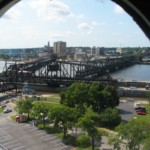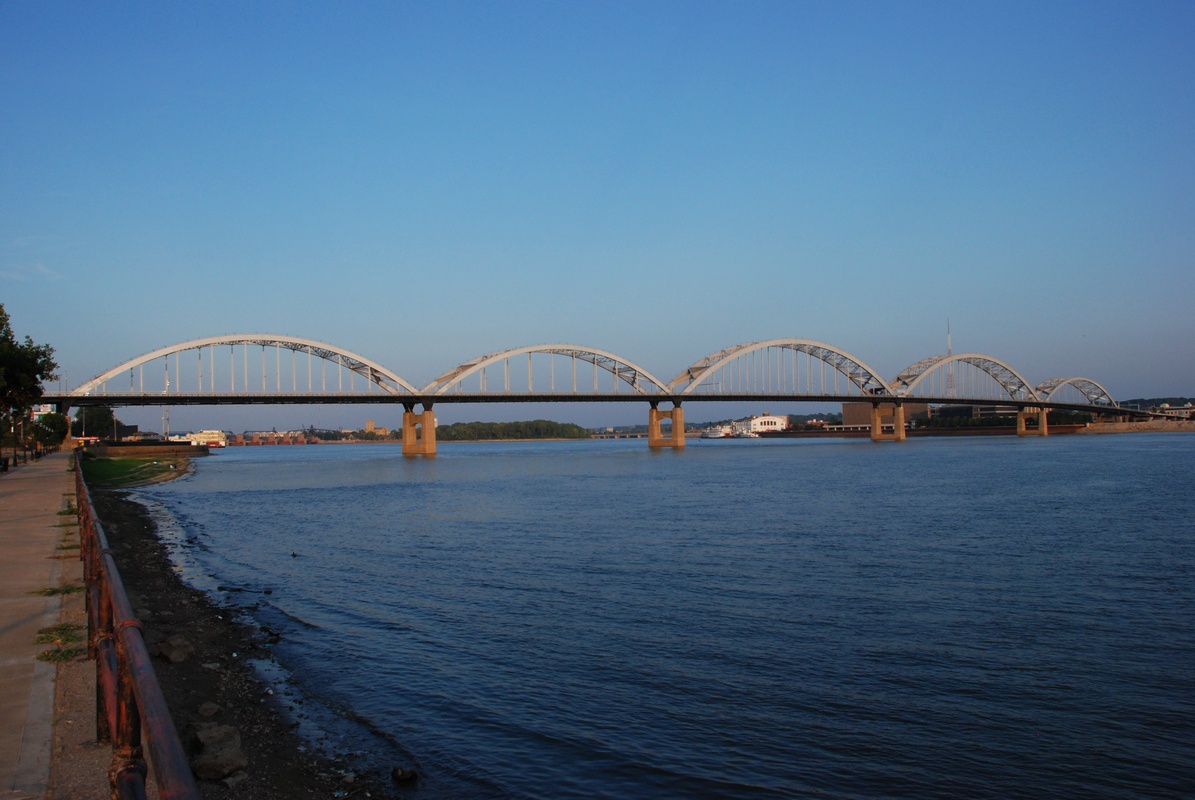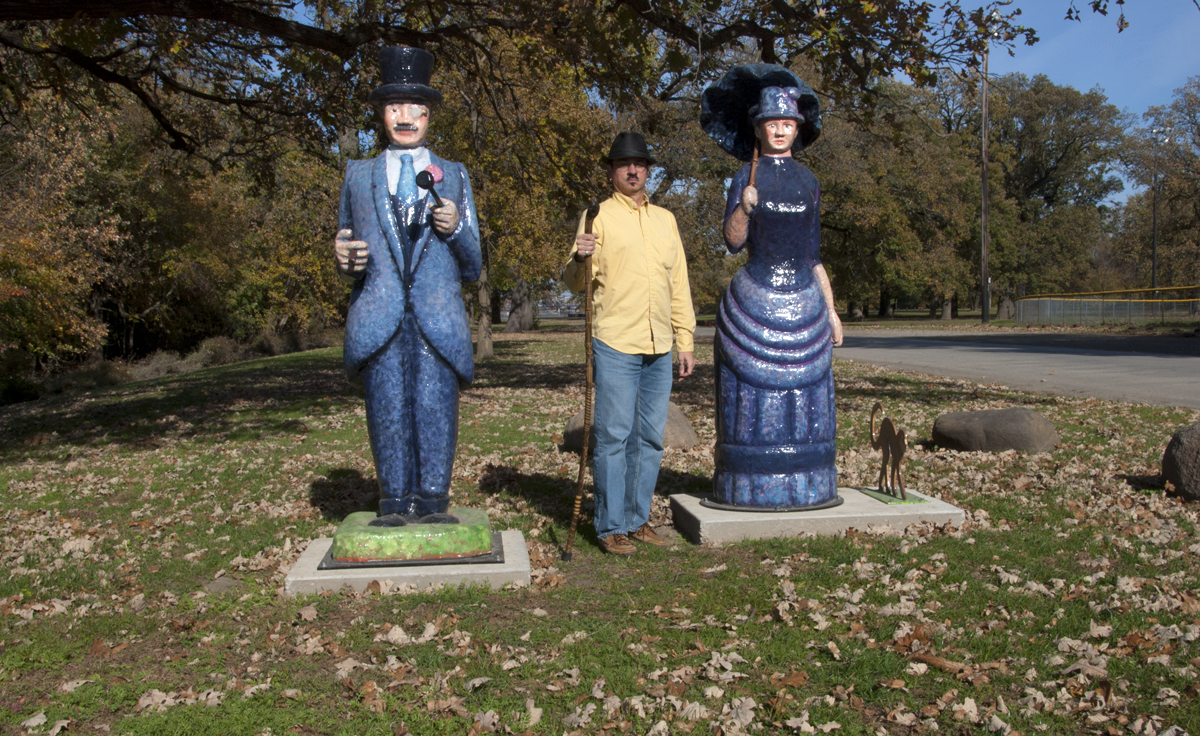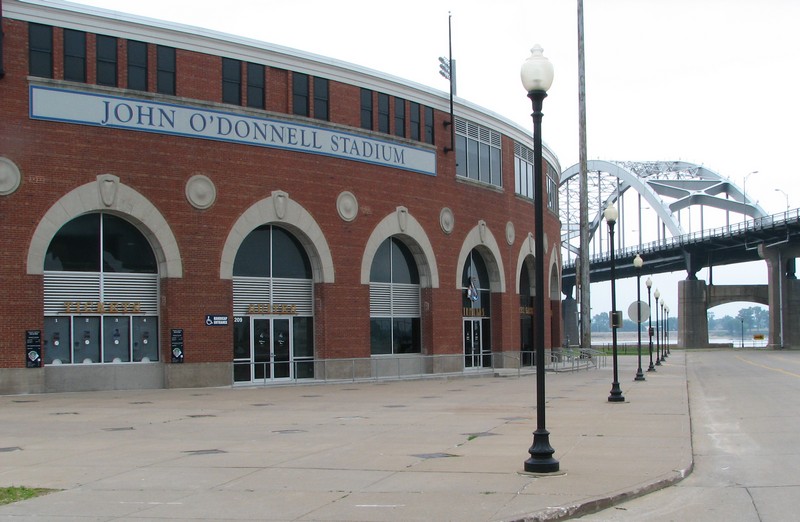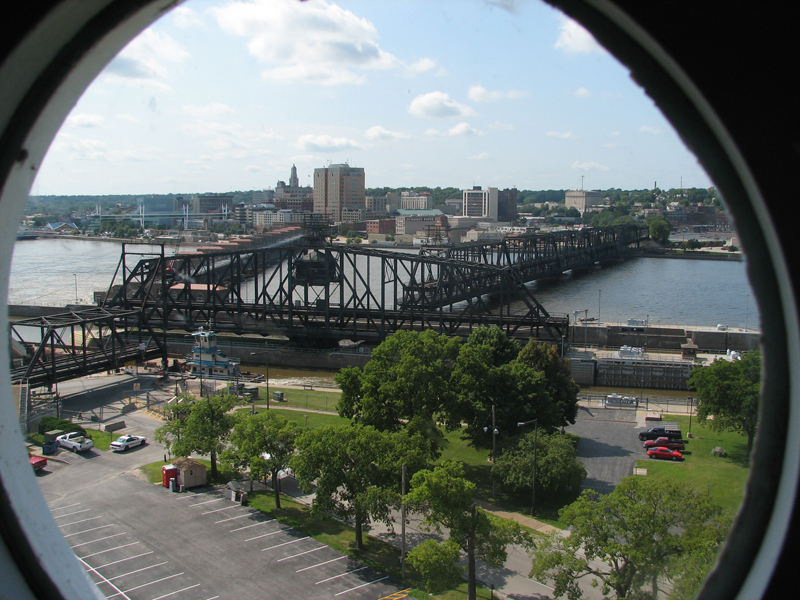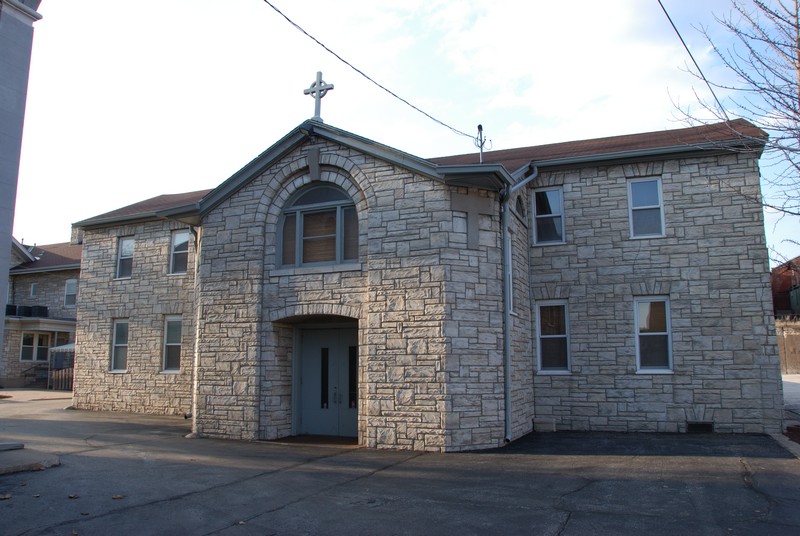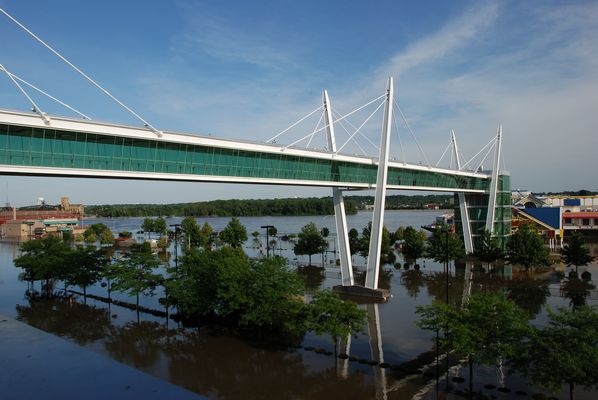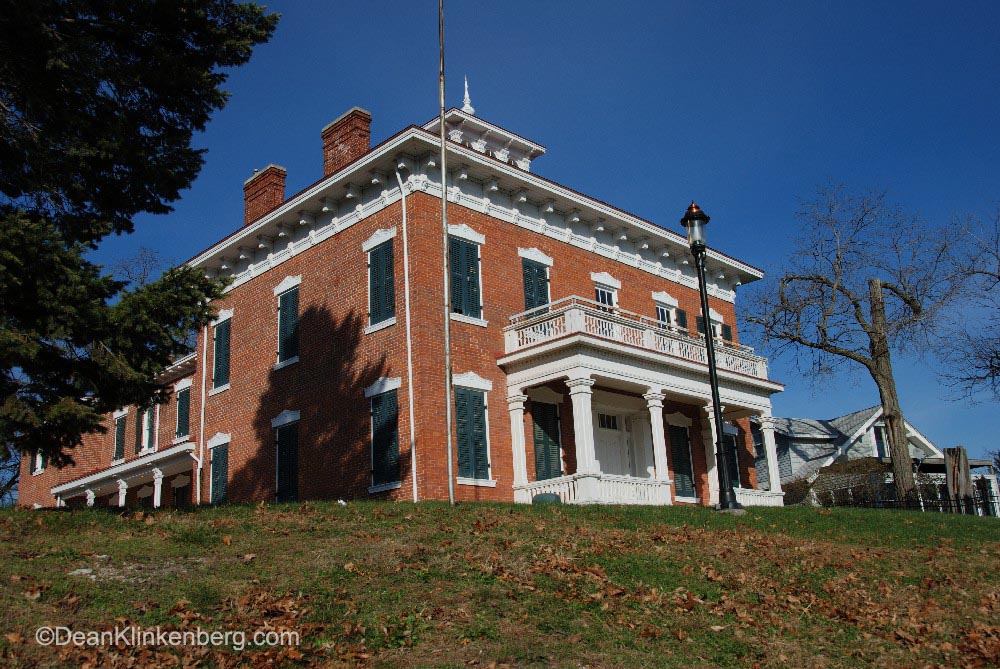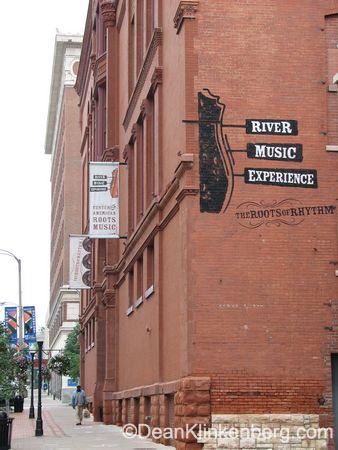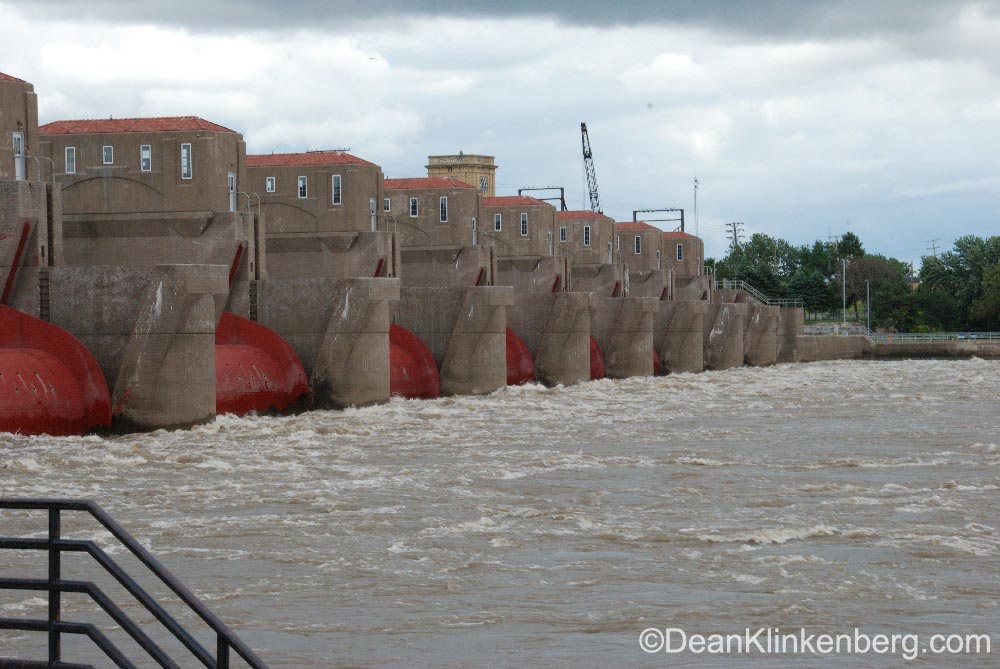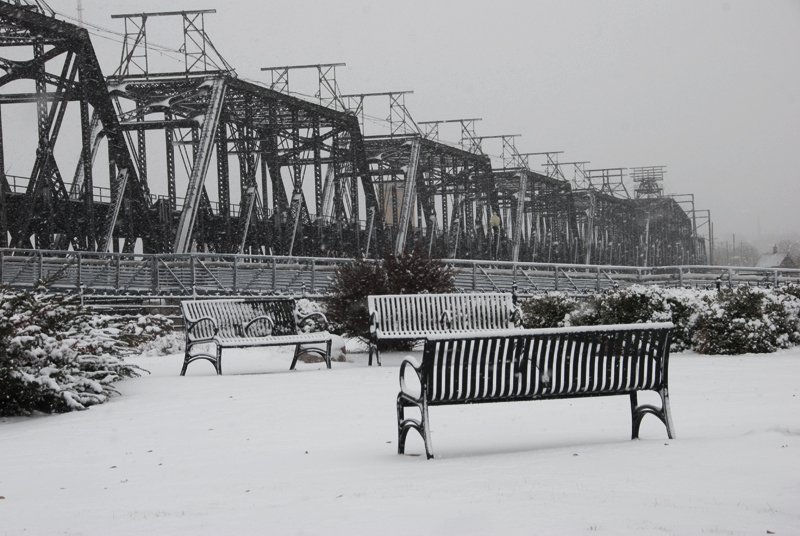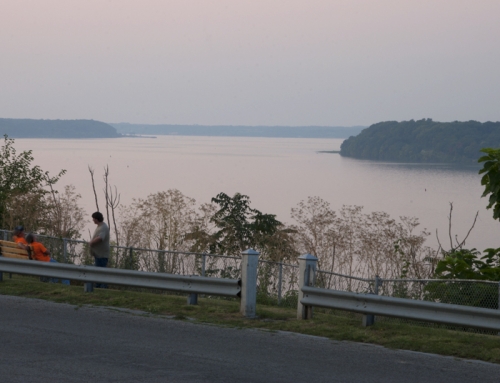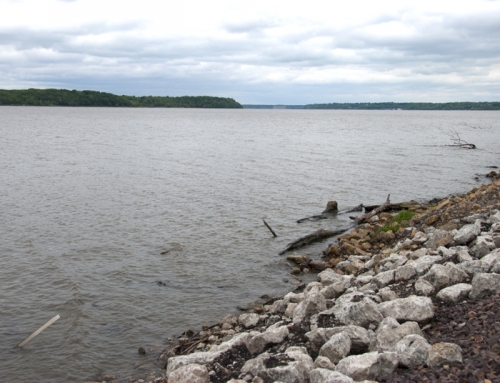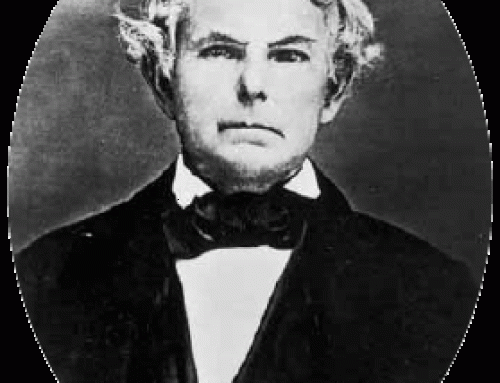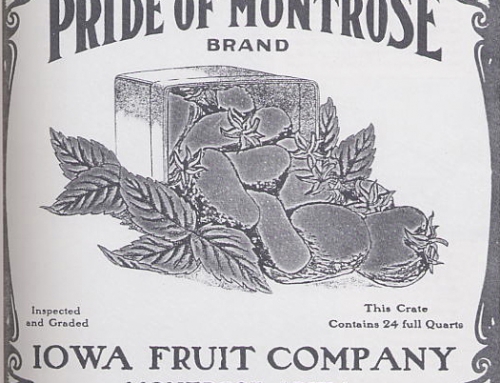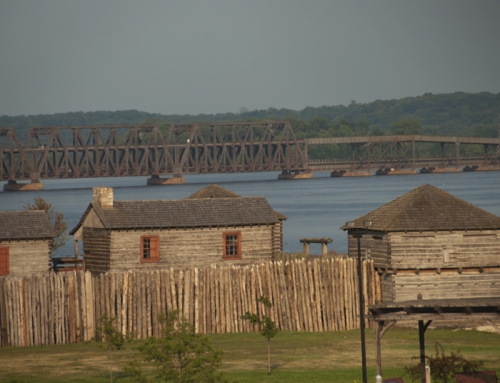Introduction
Davenport is an old river town that has been a central cog in the region’s life since it was founded. It’s a fun place to visit, with plenty to do and a beautiful and easy to get to riverfront. Give yourself at least a couple of days to explore it.
Visitor Information
Direct your questions to Visit Quad Cities (563.322.3911). In Davenport, there’s a tourist information center at Union Station on the riverfront (102 South Harrison St.) that is open seasonally.
- NOTE: See the Quad Cities overview for more information on tourism centers, festivals, and getting around the region.
History
After winning the count seat battle with Rockingham, Davenport became a key port-of-call for steamboats; by 1857, it counted nearly sixteen hundred annual steamboat landings. Goods transported up the Mississippi River supplied not only the immediate residents of the area but also farmers living in the fertile plains to the west. Davenport quickly grew into a regional commercial hub.
The arrival of thousands of Germans in the 1840s also gave Davenport a big boost. Most of the immigrants were political refugees from Schleswig-Holstein. They were wary of intimate church-state relations, largely because of the corruption they witnessed in that relationship in their homeland. When they arrived in America, they created private schools that were purely secular—a radical idea at the time. Many Germans were also deeply opposed to slavery and actively supported John Brown in his abolitionist pursuits. The Germans also brought with them a penchant for drinking and dancing on Sundays, something that the more staid Americans did not approve of. Egad! No wonder tensions were often high between the German immigrants and the second generation American families of Davenport.
Davenport also attracted a large number of immigrants from Ireland. Around 13% of Davenport’s residents claim Irish ancestry. The greatest number arrived during the famine years (An Ghorta Mhóir, or the Great Hunger). Many of the new citizens emigrated from County Clare, ordinary folks who were looking for a shot at a better life. They settled throughout Davenport but clustered around 3rd and Division Streets and in the neighborhoods around St. Mary’s Catholic Church and Sacred Heart Cathedral.
Many of those Irish immigrants helped build the first bridge across the Mississippi River in the 1850s and the earliest railroads. Some descendants of those early Irish immigrants achieved considerable success. Patrick Walsh, who was born in Davenport in 1855 on St. Patrick’s Day, landed several contracts to build railroads in the region; he went on to found a construction company whose name is still attached to many projects around the world. Michael Gannon was a prominent lawyer and politician. Fred Sharon made his mark as the long-time publisher of the Iowa Catholic Messenger, but he also had a hand in founding the local branch of the Ancient Order of Hibernians.
A unified community emerged after the Civil War, albeit one with a rebellious side. In 1884, the State of Iowa enacted an early version of Prohibition, but Davenport officials fought enforcement of the law within their boundaries. As Iowa continued to tinker with different enforcement mechanisms over the next thirty years, Davenport resisted at every step, ensuring that its residents lived in one of the few places in Iowa were alcohol could be purchased legally. Most of the taverns were confined to a four-square-block district called Bucktown where the fun continued until sunrise at its one hundred fifty bars, forty-two brothels, gambling halls, and boxing rings. Bucktown inspired Davenport’s Bishop Henry Cosgrove to call his home town “the wickedest in the nation.” Nothing like showing a little home town pride.
After remarkable growth in the nineteenth century, Davenport’s thirty-five thousand residents had reason to feel good about their town. The twentieth century, however, would be marked by continuing boom and bust periods. In the aftermath of World War I, Davenport residents looked for new leadership. In the 1920 municipal election, Davenport voters turned over city government to the Socialist Party, giving them the mayor’s office and a majority on the city council. In-fighting ended their reign after only two years, however. The relationship between the mayor and the socialist aldermen became so poor that three aldermen bugged the mayor’s office in an attempt to spy on him.
**The first Frank Dodge mystery, Rock Island Lines, is set in the Quad Cities; it was inspired by the story of gangster John Looney. Click this link to find out more. Disclosure: This website may be compensated for linking to other sites or for sales of products we link to.
Exploring the Area
Founded in 1851 to serve the logging industry, the Village of East Davenport (known locally as the East Village) was annexed by Davenport in 1856. The historic district has a collection of nineteenth century buildings that are now home to shops, restaurants, and bars. The neighborhood also hosts several festivals during the summer.
Isabel Bloom (736 Federal St.; 800.273.5436) makes popular sculptures out of cast concrete. Each figure is handcrafted and goes through rigorous quality control. Guided tours of the production facility take about an hour. Call in advance for tour times.
In 1856, Antoine LeClaire built a solid brick home high atop a bluff overlooking the Mississippi Valley. That home is now the Antoine LeClaire Historical Interpretive Center (630 E. 7th St.; 563.326.7812). The house suffered through years of neglect but an ambitious rehab effort has restored much of the building. The main attraction inside is a collection of postcards showing Mississippi River towns around the turn of the 20th century. At this time, the interior is open for group tours and special events only, but you are welcome to walk around the exterior of the home, picnic, and enjoy the views. Enter the parking lot via the alley on 8th Street.
The Davenport Skybridge is hard to miss; it’s that angular glass structure that stretches six hundred feet and seems meant to deposit people at the casino’s front door. Yes, that one. The views from the bridge are very good, especially on the south end. At night, the bridge is lit up in a variety of rotating colors. It’s kinda cool, actually. It’s open daily.
Many of the early immigrants to this area were Germans who were escaping political upheaval and economic collapse at home. The German American Heritage Center and Museum (712 W. 2nd St.; 563.322.8844) tells their stories with exhibits about the challenges they faced to start over in a new country and their lasting influence on the Quad Cities (and much of the US).
If you’re interested in the history of the Irish in the area, there’s a memorial to the Irish immigrants downtown (2nd and Harrison Sts.). There’s also a Celtic cross on the campus of St. Ambrose University just north of the athletic fields. And don’t forget to check out the only bi-state St. Patrick’s Day Parade in the country (see the Quad Cities Overview).
St. Anthony Catholic Church (417 Main St.; 563.322.3303) was the first Catholic parish in Davenport and is one of the oldest churches in Iowa. The original church was built in 1838 by Father Samuel Mazzuchelli, with support from Antoine LeClaire; that building is currently the parish religious education center. Because of an onslaught of migration to Davenport, a bigger church was needed. The new building was completed in 1853 and is still in use. The sanctuary is only open to the public about thirty minutes before a mass (Sa 5p; Su 7a, 8:30a, 10a, 11:30a); otherwise, call ahead to schedule a tour of the interior.
In 1895, Daniel David Palmer popped the back of one Harvey Lillard at his office in downtown Davenport, thus performing the first known chiropractic adjustment. In 1906, Palmer was jailed for 23 days for practicing medicine without a license, an event that recurred across the country and launched a movement to legitimize the chiropractic profession. You can learn about this (and more!) at the Palmer Family & Chiropractic History Museum in Vickie Ann Palmer Hall (115 W. 7th St.; 563.884.5714). Museum displays are scattered about the building, but you will find most of them in the basement and first floor lobby. Exhibits include a display case with a variety of animal skeletons, a giant clam shell, and a replica of the office used by Palmer. Call 24 hours in advance to schedule a visit.
One block north, the Palmer Mansion (808 Brady St.; 563.884.5714) presents a fine example of what happens when eccentricity is mixed with wealth. The porch has a number of curiosities, including a built-in pipe organ that still works, stunning samples of forbidden stitch embroidery, a room built to resemble a circus big tent, and a chair whose legs are made from genuine elephant feet. Tours are generally offered on Friday mornings at 11 when classes are in session, but you must call at least a day in advance to make a reservation.
The Putnam Museum (1717 W. 12th St.; 563.324.1933) hosts several excellent exhibits on the region’s natural and cultural history. River, Prairie, and People covers the region’s history, from pre-colonial times to the present. Black Earth/Big River is an interactive exhibit about the ecology of the Mississippi River valley. The museum also has an IMAX theater with rotating shows.
Parks Along the Mississippi River
Lindsay Park (2200 E. River Dr.) in East Davenport is the site where Black Hawk camped before signing the Treaty of 1836 that ceded most of Iowa to the U.S. government and where artist George Catlin painted his portrait. The park has a good view of the river and is a nice spot for a picnic; free parking is available along 11th Street.
Head over to Lower Lindsay Park (E. River Dr. at Mound St.) to check out one of the area’s more unusual attractions: the nearly life-size sculptures created by artists Ted McElhiney and Thom Gleich that were inspired by the characters from Seurat’s painting, A Sunday on La Grande Jette.
River Heritage Park (640 US Highway 67) has a gazebo, a historical marker, and great views of the river.
Don’t forget to make time to relax and enjoy the riverfront, as long as it’s not underwater. LeClaire Park (400 W. Beiderbecke) has a bandshell and is the site of many summer festivals.
On the other side of the bridge, Centennial Park (315 S. Marquette) has a skate park, a water spray area, and plenty of places to picnic or sit and watch the river.
Veterans Memorial Park (315 S. Marquette) is next to Centennial Park; you’ll find more places to relax and picnic next to the river, plus a boat ramp.
Credit Island Park (2500 W. River Dr; 563.326.7812), the site of an early French trading post, is a good spot to rest your feet or enjoy a picnic, and it’s great for people watching, too.
Nahant Marsh Education Center (4220 S. Wapello Ave.; 563.336.7766) is a 305-acre preserve created on the site of a former shooting range. A cooperative effort between public and private agencies helped to remove hazardous amounts of lead and restore the marsh. The preserve has a couple of short walking trails and viewing platforms good for bird-watching, especially during migration season.
Culture & Arts
The Bix Beiderbecke Museum & Archive (129 N. Main St.; 563.326.1333, x114) showcases the life and legacy of the city’s musical prodigy and jazz pioneer. In his tragically short life, Beiderbecke stood out as one of the best cornetists of his day. He impressed his contemporary, the legendary Louis Armstrong, and played with the top bands of the 1920s. The museum brings Beiderbecke’s story to life.
The Figge Art Museum (225 W. 2nd St.; 563.326.7804), the large glass structure that looks something like a fragile towboat, features great art from around the world. Most of the exhibits turn over frequently, so you’ll want to make regular visits to see what’s new. Some of the highlights among the permanent exhibits include a colorful collection of Haitian art, paintings by native Midwesterner artists Thomas Hart Benton and John Steuart Curry, and the Grant Wood Gallery.
See the Quad Cities Overview for Cultural and Arts events.
Sports & Recreation
Along the riverfront, there’s a paved walking/bicycling path that extends from Credit Island Park to the Isle Casino in Bettendorf.
Modern Woodmen Park stands out as one of America’s great baseball stadiums. Completed in 1931, it is the home field for the Quad Cities River Bandits (209 S. Gaines St.; 563.322.6348), a minor league baseball team affiliated with the Kansas City Royals. The stadium is in one of the most scenic spots for a baseball game—anywhere. A tall Ferris wheel, operates next to the stadium, which offers great views of the riverfront as you rotate around. It just might renew your love for baseball. Next to the stadium is a tall Ferris wheel, where you’ll get great views of the riverfront as you rotate around.
Getting on the River
Between Memorial Day and Labor Day you can zip between cities on both sides of the river on the Channel Cat Water Taxis (309.788.3360). Catch a ride from the stop at the Village of East Davenport.
Entertainment and Events
Davenport’s Rhythm City Casino (7077 Elmore Ave.; 563.328.8000) has a land-based home at the intersection of Interstates 74 and 80. The 285,000 square foot complex includes about 800 slot machines and 35 gaming tables.
Davenport has several venues to take in live shows. The Redstone Room at Common Chord (129 Main St.; 563.326.1333) and the Raccoon Motel (315 E. 2nd St.; 563.424.0819) offer intimate venues to enjoy live music. The Adler Theatre (136 E. 3rd St.) specializes in performing arts, including touring shows. The restored Capitol Theatre (330 W. 3rd St.) is another good venue for national touring acts and shows.
Farmers Market
Fill your shopping basket on Wednesday afternoons, Saturday and Sunday mornings at the Freight House Farmers Market (421 W. River Dr.).
Festivals
See the Quad Cities Overview for information on festivals in Davenport.
**Davenport is covered in Road Tripping Along the Great River Road, Vol. 1. Click the link above for more. Disclosure: This website may be compensated for linking to other sites or for sales of products we link to.
Where to Eat and Drink
Get your java fix at Redband Coffee Company (329 E. 4th St. and 110 W. 13th St.; 563.823.1107), which has re-purposed a couple of cool old buildings to serve its house-roasted coffees, pastries, and breakfast sandwiches.
Chocolate Manor (110 E. 2nd St.; 563.355.6600) is a family-run boutique chocolatier. Their hand made products include gorgeous truffles, sinful dark chocolates, and luscious chocolate-covered fruits. Stop in, sample, and stock up.
Satisfy your craving for a frozen treat at local favorite Whitey’s Ice Cream (1230 W. Locust St.; 563.322.0828).
11th Street Precinct Bar and Grill (2108 E. 11th St.; 563.324.9545) serves sandwiches and pizza. Check out the pork tenderloin sandwich, which violates all kinds of Midwestern cooking rules by not being breaded and fried.
For snacks and drinks with a view, head to the top of the Current Hotel (215 N. Main St.), where the rooftop bar UP (563.231.9557) is waiting for you with tapas and cocktails.
Lagomarcinos (2132 E. 11th St.; 563.324.6137) has a more celebrated location in Moline, but this one serves up the same delicious homemade ice cream, hot fudge sundaes, and old-school sodas.
Boozies Bar & Grill (114 ½ W. 3rd St.; 563.328.2929) consistently gets props for its burgers, especially the namesake Boozie Burger topped with bacon, a trio of cheeses, and just about anything else you could want. If you are not in the mood for a burger, they have an assortment of other pub-inspired sandwiches and entrees.
It probably doesn’t make sense to write that a place that has been pleasing people for over a decade has largely flown under the radar, but that’s the case for Café D’Marie (614 W. 5th St.; 563.323.3293). The restaurant occupies a historic Victorian house in Davenport’s Gold Coast neighborhood. The dining areas are cozy and bright and the food prepared fresh every day. Expect a tasty selection of quiches, soups, sandwiches, and salads, plus tasty tea and coffee drinks. They are only open for lunch.
Harris Pizza has two locations in Davenport, one on the west side (1601 W. 3rd St.; 563.326.3551) and another on the east side (524 E. Locust St.; 563. 322.2411).
Front Street Brewery (208 E. River Dr.; 563.322.1569) serves up a range of salads, sandwiches, and above average pub-grub entrees. If you just want to sip on one of their hand-crafted beers, they have a taproom just down the street (421 W. River Dr.).
For an inspired take on the cuisines of southeast Asia, settle in to The Miss Phay Café (512 Brady St.; 563.888.1053) where you can enjoy a steaming bowl of pho, steaming noodle dishes, and curries.
For a more upscale experience, dine at the classy Bix Bistro at the Hotel Blackhawk (200 E. 3rd St.; 888.525.4455). The menus change with the availability of fresh, locally sourced ingredients, but lean into steaks and fish.
Where to Sleep
Davenport has a full range of accommodation options, as one would expect. Most of the chain motels are clustered on North Brady (US Highway 61) near Interstate 80, which is about a 10-minute drive from the riverfront.
Camping
Interstate RV Park (8448 Fairmount St.; 563.386.7292), just north of I-80 at Northwest Boulevard, has 98 sites including many with full hookups.
Bed-and-Breakfast Inns
The Beiderbecke Inn (532 W. 7th St.; 563.323.0047) is a handsome bed-and-breakfast in the house built by the grandparents of Bix Beiderbecke; all four rooms have a private bath. The Mississippi Room has a balcony and a nice view.
Moderate and up
A stunning renovation in 2010 brought back to life the storied but neglected Hotel Blackhawk (200 E. 3rd St.; 888.525.4455), where presidents and celebrities have stayed in the hotel’s 100-year history. The 130 spacious rooms offer upscale lodging in the heart of Davenport.
Resources
- Main Post Office: 933 W. 2nd St.; 563.323.0306.
- Davenport Public Library—Main Branch: 321 Main St.; 563.326.7832.
- The local newspaper is the Quad City Times.
Where to Go Next
Heading upriver? Check out Bettendorf.
Heading downriver? Check out Buffalo.
Community-supported writing
If you like the content at the Mississippi Valley Traveler, please consider showing your support by making a one-time contribution or by subscribing through Patreon. Book sales don’t fully cover my costs, and I don’t have deep corporate pockets bankrolling my work. I’m a freelance writer bringing you stories about life along the Mississippi River. I need your help to keep this going. Every dollar you contribute makes it possible for me to continue sharing stories about America’s Greatest River!
Davenport Photographs
A Song for Davenport
Crossing the Mississippi Again by Joni Laurence (2006)
©Dean Klinkenberg, 2024, 2021, 2018,2013,2011
